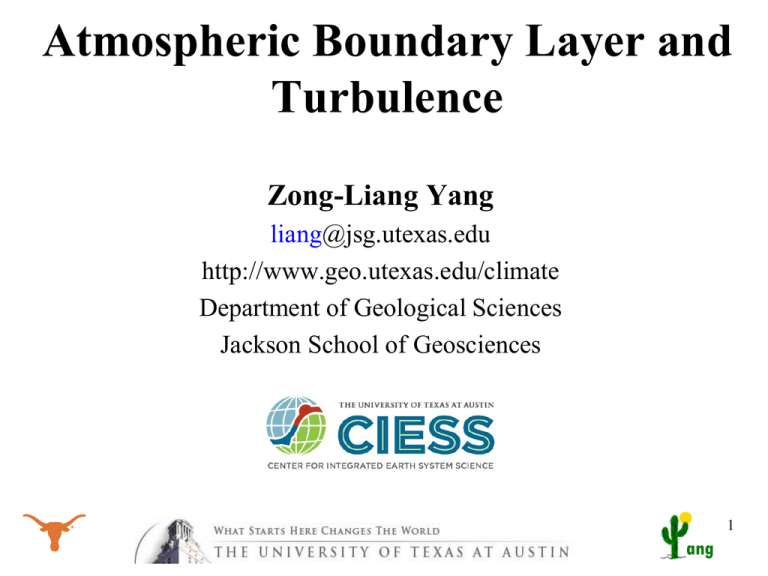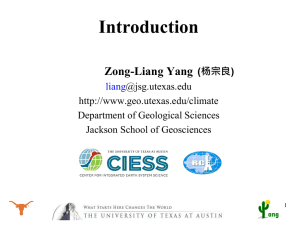ang - The Department of Geological Sciences
advertisement

Atmospheric Boundary Layer and Turbulence Zong-Liang Yang liang@jsg.utexas.edu http://www.geo.utexas.edu/climate Department of Geological Sciences Jackson School of Geosciences 1 ang Outline • Definition and Basic Properties • Why Study ABL? • Structure of ABL • Features of Wind Speed Variation • Surface Energy Balance • Summary 2 ang ABL: Definition and Basic Properties The layer of air near the Earth’s surface, also called the Planetary Boundary Layer. It is that portion of the lower troposphere that feels the effects of the underlying surface within about 30 minutes or less. The surface influences ABL by friction and by heat fluxes at the surface. This layer is turbulent and is well mixed. Turbulence is generated by wind shear (wind is approximately geostrophic at the top of the ABL but zero at the surface). Temperature gradients can either generate or suppress turbulence. Temperatures vary diurnally, unlike the free atmosphere above. Its height evolves with time over the course of a day. Boundary layer clouds: fair-weather cumulus, stratocumulus, fog. Maximum height: usually ~1 km, ~3 km over deserts, dry fields and boreal forests; 1–2 km over wetter surfaces. 3 ang Why Study ABL? Humans live in the ABL. Fluxes are mediated here. 50% of the atmosphere’s kinetic energy is dissipated in the boundary layer. It is the location of the source and sink of many trace gases (including water vapor, CO2, ozone, methane) and dusts/pollutants. It is a reservoir of trace gases and pollutants. It is important for local forecasting. There is a strong effect on the rest of the atmosphere. Boundary-layer clouds are very important for climate. 4 ang Structure of ABL (1/2) During a clear day, it consists of a roughness sublayer (air flows around individual roughness elements – grass, plants, trees, or buildings), a surface boundary layer, a well-mixed layer and a capping entrainment layer. The ABL is capped by a temperature inversion, which inhibits mixing and confines pollution below it. Potential temperature and other quantities are constant with altitude. Earth’s rotation becomes important, and the wind direction veers with height. Formerly known the constant flux layer, ~ 100 m thick or 10% of the ABL ang 5 Structure of ABL (2/2) 6 ang Features of the Wind Speed Variation 153 metres 64 metres • Increase in mean (average) 12 metres speed with height Wind speed (m/s) 35 30 • Turbulence (gustiness) at each 25 20 height level 15 10 5 • Broad range of frequencies in 0 the fluctuations 0 1 2 3 Time (minutes) 4 5 • Similarity in gust patterns at lower frequencies Wind speeds from 3 different levels recorded from a synoptic gale 7 ang Surface Energy Balance 8 ang Earth’s Global Energy Budget 80% of net radiation at the surface is used for evaporation! Trenberth et al. (2009) ang Air Flow and Turbulent Vortices Air flow can be imagined as a horizontal flow of numerous rotating eddies, a turbulent vortices of various sizes, with each eddy having 3D components, including vertical components as well. The situation looks chaotic, but vertical movement of the components can be measured from the tower. ang Determine Vertical Fluxes ang Surface Energy Balance ang Surface Energy Balance ang Surface Energy Balance ang Surface Energy Balance ang Surface Energy Balance ang Surface Energy Balance ang Surface Energy Balance ang Surface Energy Balance ang Surface Energy Balance ang Surface Energy Balance ang Surface Energy Balance ang Supplementary Materials ang Reynolds Decomposition and Eddy Covariance ang Reynolds Decomposition and Eddy Covariance ang Bulk Aerodynamic Formulas (Parameterizations) τ = ρ CDM Ur2 SH = cp ρ CDH Ur [Ts – Ta(zr)] LE = L ρ CDE Ur [qs – qa(zr)] CDN = [κ / ln(zr/z0)]2 CDM = CDN,M fM(RiB) CDH = CDN,H fH(RiB) CDE = CDN,E fE(RiB) ang Global Distribution of Sensible Heat Flux ang http://www.cdc.noaa.gov/ Global Distribution of Latent Heat Flux ang http://www.cdc.noaa.gov/ Regional Patterns of The Surface Energy Balance West Palm Beach, Fl energy balance (ly/day) West Palm Beach, Florida is located in a warm and moist climate. Latent energy transfer into the air is greatest during the summer time which is the wettest period of the year, and when net radiation is the highest. During the summer, sensible heat transfer decreases as net radiation is allocated to evaporation and latent heat transfer. Yuma, AZ energy balance (ly/day) At the other extreme is Yuma, Arizona, a warm and dry climate. The most noticeable characteristic of this place is the lack of latent heat transfer. Though ample radiation is available here, there is no water to evaporate. Nearly all net radiation is used for sensible heat transfer which explains the hot dry conditions at Yuma. ang 30 ang Lawrence et al., 2011 500+ 31 ang Summary Additional Major References “The ABL” by Roland Stull Prof. Zong-Liang Yang +1-512-471-3824 liang@jsg.utexas.edu http://www.geo.utexas.edu/climate 32 ang









